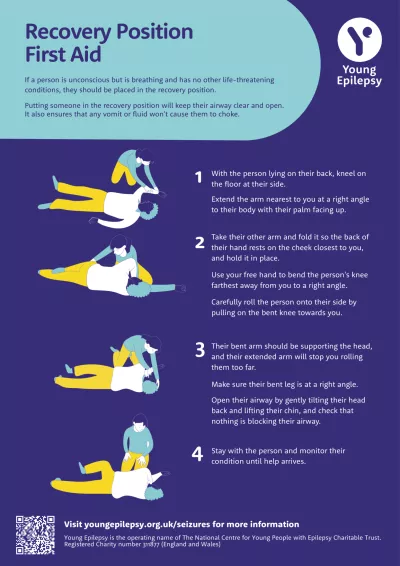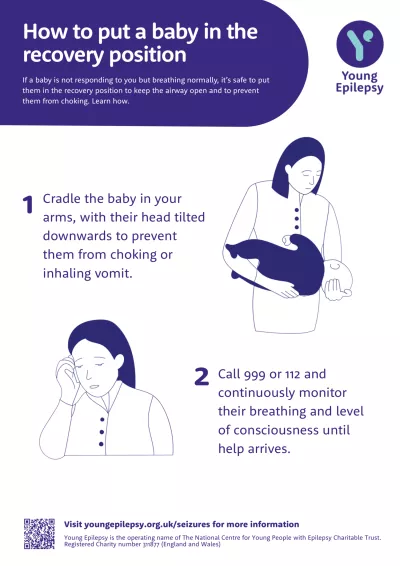On this page we tell you about some of the most important things to remember when helping someone who is having a seizure, and we cover some of the common signs and symptoms of seizures.

How can I help someone having a seizure?
Back to Epileptic SeizuresImportant things to remember
There are many different types of seizures, and some seizure types need different kinds of help. But even if you don’t know what type of seizure someone is having, these are some of the important things to remember when helping someone who’s having a seizure:
- Time the seizure
- Stay with them until the seizure is over
- Be calm and reassure them
- Make sure they’re safe and the area is cleared of anything that could hurt them
- Don’t put anything in their mouth
- Listen to how they want to be supported
Experiencing a seizure can be frightening, confusing, and often traumatising. Seeing someone have a seizure for the first time can be scary. Knowing what to do if witnessing a seizure can help you stay calm and help keep everyone safe.
It is important to stay with the person and keep them safe until the seizure is over. Don't give them any food or drink until they are fully recovered and back to their normal self. Most seizures usually last a few seconds or minutes and stop on their own. Some seizures are over so quickly, you may not even realise it happened.
It is also important to time the seizure. This is because it will help you decide if the seizure is an emergency and if you need to call an ambulance. Seizures that last for more than five minutes need urgent medical help.
Not everyone who has a seizure needs an ambulance. But if someone has hurt themselves during a seizure or the seizure lasts a long time, they need emergency help.
When should I call an ambulance?
Call 999 for an ambulance if…
- Thay have never had a seizure before
- They are not breathing or are blue around the lips
- The seizure lasts more than 5 minutes
- They are not responding after the seizure has stopped
- They hurt themselves during the seizure
How do I know if someone is having a seizure?
Signs that someone is having a seizure depend on the type of seizure. They may be alert during their seizure, and able to remember it afterwards, or they may not remember it at all.
Some possible signs someone may be having an epileptic seizure include:
- uncontrollable jerking and shaking
- losing awareness and staring blankly into space
- becoming stiff (rigid)
- falling to the floor
Tonic-clonic seizures
Tonic-clonic seizures are the type of epileptic seizure that most people probably know about or might have seen on TV. Symptoms usually start with the ‘tonic’ phase, where a person will become stiff and fall unconscious, before moving into the ‘clonic’ phase, where their limbs will begin to jerk uncontrollably.
When someone is having a tonic-clonic seizure, it is important not to move them unless they are in danger but to move anything that could cause injury out of harm’s way. If you can do so without risking injury, place something soft under their head. Time the seizure, place the person in the recovery position when the seizure has stopped, and wait until they regain consciousness.
Find out how more about helping someone having a tonic-clonic seizure
Most seizures stop by themselves. But for tonic-clonic seizures, if they don’t, or are left untreated, they are the most dangerous type of seizure and need urgent attention. They can cause brain damage, organ failure and potentially death.
If you want to find out more about the different seizure types, check out our ‘seizure types’ page.
Witnessing a seizure
Seeing someone have a seizure can be stressful and it’s easy to forget some of the details. If you look after a child or young person, it’s important that you write down the details of the seizure. Where possible, try to do this every time you see them having a seizure. You should write it down on a ‘seizure observation and treatment form’ as soon as possible.
Download ‘Seizure observation and treatment' form or a ‘Seizure record chart’.
Give a detailed description of what happened before, during and after the seizure. It’s best just to describe what you saw rather than trying to identify the type of seizure. That way, you’re less likely to miss important information.
This information will help doctors to:
- Make a correct diagnosis
- Identify patterns and changes in the child’s condition
- Decide the best way to manage and treat their condition
Keeping accurate seizure records
As soon as you can, take time to sit down and write a description of exactly what happened.
Make a note of:
- Any changes in breathing
- Movements of arms and legs
- How long it took for them to fully recover
- Head movements
- Eye movements
- Medication given
- How long the movements or behaviours lasted
- Changes in skin colour
- Changes in how they respond to you
It’s also helpful to note what you were doing before the seizure started and when it happened.
Don’t forget to keep a diary with the exact times and dates.
It will be very helpful if you can make a video recording of seizures. But always make sure the person is safe before worrying about a recording.
More ways you can help
- Recovery position
- Baby recovery position
Recovery position
During some seizures, such as tonic-clonic seizures, the person might fall to the floor. If someone has fallen to the floor during their seizure, you should put them in the recovery position once the seizure has ended. Follow these steps from the NHS and watch their video on how to put someone in the recovery position on their website.
- With the person lying on their back, kneel on the floor at their side.
- Extend the arm nearest you at a right angle to their body with their palm facing up.
- Take their other arm and fold it so the back of their hand rests on the cheek closest to you and hold it in place.
- Use your free hand to bend the person's knee farthest away from you to a right angle.
- Carefully roll the person onto their side by pulling on the bent knee towards you.
- Their bent arm should be supporting the head, and their extended arm will stop you rolling them too far.
- Make sure their bent leg is at a right angle.
- Open their airway by gently tilting their head back and lifting their chin, and check that nothing is blocking their airway.
- Stay with the person and monitor their condition until help arrives.

Baby recovery position
Follow these steps from St John’s Ambulance or watch a video on how to put a baby in the recovery position from their website.
- If the baby is not responding to you, first perform a primary survey. If this establishes that they are unresponsive but breathing, put them in the recovery position.
- Cradle the baby in your arms, with their head tilted downwards to prevent them from choking or inhaling vomit.
- Call 999 or 112 for emergency help and continuously monitor their breathing and level of consciousness until help arrives.

Last reviewed July 2025.
Next review due July 2028.
If you would like to find out more about how we produce our information, or the sources of evidence we use, please contact us at healthinfo@youngepilepsy.org.uk
Find out about different types of seizures
What is an epileptic seizure?
Discover what an epileptic seizure is, how to identify a seizure in babies and infants, and about non-epileptic seizures and episodes.
Seizure types
Learn about the differences between focal and generalised seizures and how to identify each.
Generalised onset seizures
Learn about generalised onset seizures, their types, causes, and management. Find resources and support for children and young people with epilepsy.
Focal onset seizures
Learn about epileptic seizures in babies and infants, including types and signs, from birth to one year old.
Seizure triggers
Learn about common seizure triggers in children and young people, including poor sleep, missed medication, and flickering lights.
Status epilepticus, prolonged or cluster seizures, and emergency medication
Learn about status epilepticus, prolonged seizures, and emergency medication for managing seizures lasting more than five minutes.
Monitoring seizures
Young Epilepsy’s information about nocturnal seizure monitors and other equipment, apps and services for parents of children with epilepsy.
More information about epilepsy
Causes of epilepsy
Learn about the causes of epilepsy, including genetic, metabolic, unknown origins, and epilepsy in infants, from Young Epilepsy.
Epilepsy syndromes
Learn about common childhood and rare infancy epilepsy syndromes in this informative guide from Young Epilepsy.
Epileptic seizures
Understand epileptic seizures, their types, causes, and management. Find resources and support for living with epilepsy.
Diagnosing epilepsy
Find out how epilepsy is diagnosed, what to expect at your first appointment, and how to get the right support for children and young people.
Treatments for epilepsy
Explore various epilepsy treatments, including medication, surgery, and dietary options. Find resources and support for managing epilepsy effectively.
Common co-occurring conditions
Explore common co-occurring conditions like autism, ADHD and dyspraxia in children with epilepsy, and how to recognise and support them early.
Sudden unexpected death in epilepsy (SUDEP)
Learn about SUDEP, who is at risk, and how to reduce the chances of epilepsy-related death in children and young people through safety and support.

This page is PIF TICK approved
Young Epilepsy is a certified member the PIF TICK scheme. The scheme is the only independently assessed certification for both print and digital health information.

